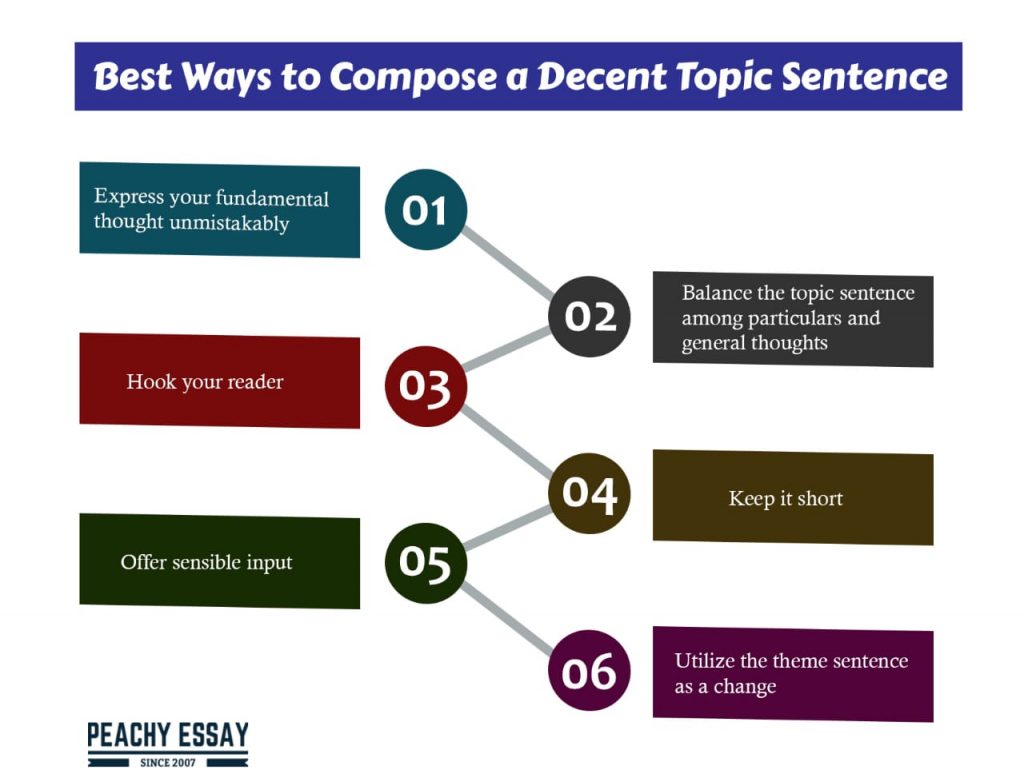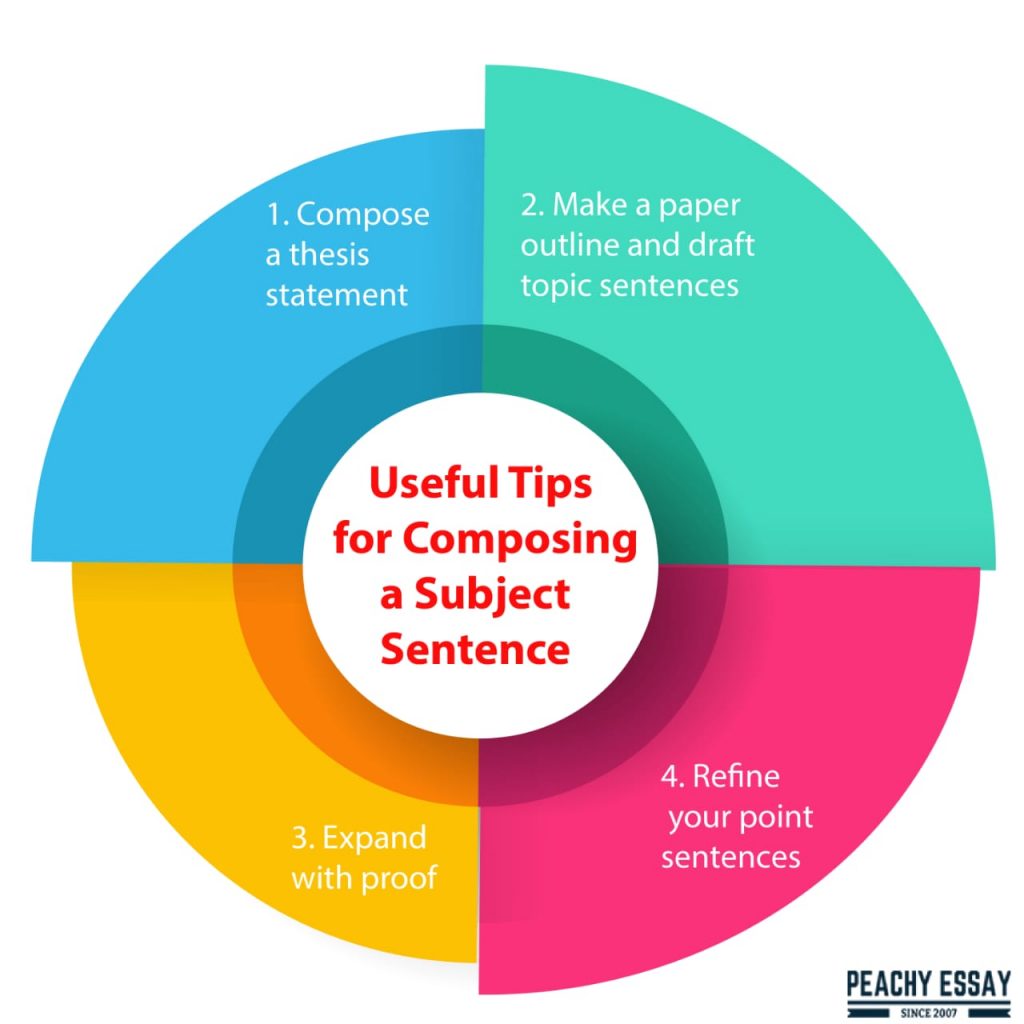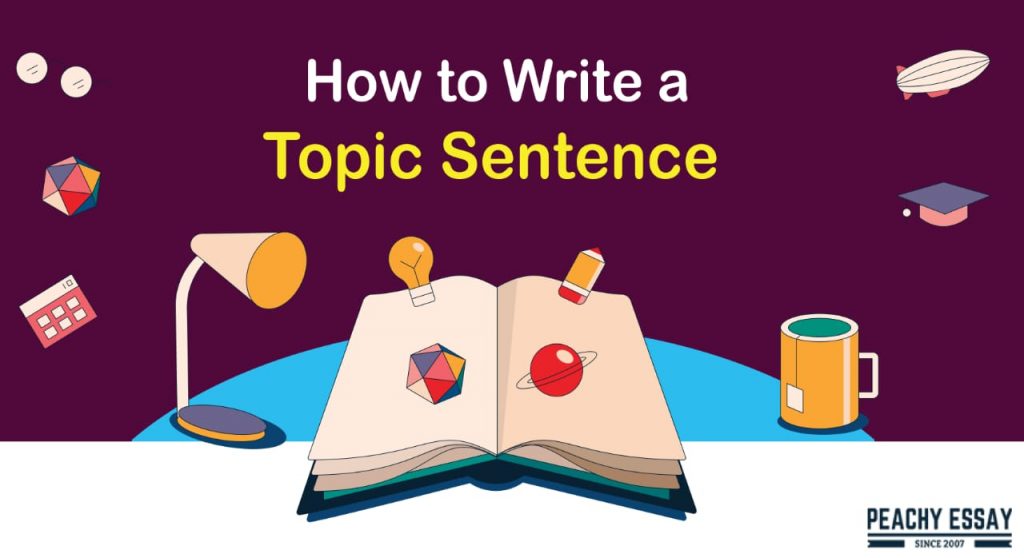A topic sentence is a fundamental sentence in any section. Sometimes, a topic sentence is referred to as a central sentence and it helps put together the passage by summing up the section’s data. In conventional composition, the topic sentence is normally the main sentence in a section.
Purpose of a Topic Sentence
A topic sentence basically advises readers about the remainder of the paragraph. All sentences after it need to give more data about that sentence, demonstrate it by offering realities about it, or depict it in more detail. For instance, if the topic sentence concerns the kinds of endangered species that live in the sea, at that point, each sentence after that needs to elucidate that subject.
Topic sentences likewise need to relate to the thesis of the paper. The thesis resembles a guide that will tell the reader or audience where you are going with this data or how you treat it.
Parts of Topic Sentences
Here are the parts of the topic sentences.
The topic of the paragraph
This topic comes from your initial thesis statement. Your topic sentence in the principal supporting passage will address the primary heading you expressed in your paper’s initial proposal explanation.
Topic statement
This is a finished sentence that contains a scientific action word. This action word ought to characterize the particular reason or the particular impact of the logical or abstract gadget/procedure corresponding to the importance of the piece your exposition is dissecting and how that significance is passed on.
Exposition’s general thesis statement
A topic sentence has a “course” that shows how you will uphold and exhibit your factious point to the audience. In contrast to the thesis statement, your topic sentence is zeroing in on a particular reason.
Association of your supporting point
Interface your supporting point, hence the motivation behind your supporting passage, to the theoretical thought of the piece you are dissecting as effectively-recognized in your general exposition’s thesis statement. The widespread thought ought to be expressed in interchangeable terms like the one utilized in the thesis statement.
Location of Topic Sentences
A topic sentence can show up anyplace inside a passage or can be suggested. In college informative composition, putting a topic sentence toward each section’s start makes it simpler for readers to follow the paper and for essayists to remain on point; however, authors ought to know about varieties and keep up the adaptability to adjust to various composing projects.
Here are examples showing changing areas for the topic sentence. In every model, the point sentence is bolded.
Topic Sentence Appears at the Beginning of a Paragraph
In the wake of scrutinizing the new TV guide this week, I asked why we are as yet being besieged with unscripted TV dramas, a plague that keeps on obscuring our wireless transmissions. Alongside the arrival of watcher top choices, we are to be reviled with one more careless creation. Detainee follows the everyday lives of eight rural homemakers who have decided to be placed in prison for the motivations behind this phoney mental test. A see for the primary scene shows the typical tears and fits related to unscripted TV. I fear figuring out what makers will think of next season and expecting that different watchers will communicate their analysis. These makers should stop the consistent stream of pointless shows without plot lines. We’ve had sufficient unscripted TV to last us a lifetime!
The main sentence tells readers that the passage will be about unscripted TV shows, and it communicates the essayist’s abhorrence for these shows using the word besieged. Every one of the accompanying sentences in the passage upholds the point sentence by giving additional data about a particular unscripted TV show and why the essayist thinks that it’s unappealing. The last sentence is the finishing up sentence. It emphasizes the primary concern that watchers are exhausted with unscripted TV shows by utilizing various words from the theme sentence.
Passages that start with the topic sentence move from the general to the particular. They open with an overall assertion about a subject (unscripted TV dramas) and afterwards examine explicit at the start of the principal passage.
Topic Sentence at the End of the Paragraph
A year ago, a feline made a trip 130 miles to arrive at its family, who had moved to another state and had given up their pet. Even though it had never been to their new home, the feline had the option to find its previous proprietors. A canine in my area can foresee when its lord is going to have a seizure. It ensures that he doesn’t hurt himself during an epileptic fit. Contrasted with numerous creatures, our own faculties are practically dull.
The last sentence of this section is the topic sentence. It draws on explicit models (a feline that found its proprietors and a canine that can anticipate seizures) and afterwards offers an overall expression that decides from these models (creatures’ faculties are superior to people’). For this situation, the supporting sentences are set before the point sentence, and then the finishing up sentence is equivalent to the topic sentence. This procedure is now and again utilized in enticing composition. The essayist produces itemized models as proof to back up their point, setting up the reader to acknowledge the closing topic sentence as reality.
Topic Sentence in the Middle of the Paragraph
For a long time, I experienced extreme uneasiness each time I took a test. Hours before the test, my heart would start beating, my legs would shake, and now and again, I would turn out to be genuinely incapable of moving. A year ago, I was referred to a subject matter expert who lastly figured out how to control my uneasiness—breathing activities. It appears to be so basic; however, by doing only a couple of breathing two or three hours before a test, I step by step got my nervousness levelled out. The activities help moderate my pulse and cause me to feel less on edge. Even better, they require no pills, no hardware, and almost no time. It’s stunning how breathing accurately has assisted me with learning to deal with my tension indications.
In this section, the bolded sentence is the topic sentence. It communicates the principle thought—that breathing activities can help control nervousness. The previous sentences empower the essayist to develop to his central matter (breathing activities can help control tension) by utilizing an individual tale (how he used to experience the ill effects of uneasiness). The supporting sentences at that point develop how breathing activities help the author by giving extra data. The last sentence is the finishing up sentence and rehashes how breathing can help oversee tension. Setting a point sentence in a section is regularly utilized in experimental writing. If you notice that you have utilized a subject sentence in a passage in a scholarly article, read through the section cautiously to ensure that it contains just one significant theme.
How to Write a Topic Sentence
Understanding how to compose subject sentences is crucial for fruitful composition. A topic sentence normally comes toward the start of a passage and tells your reader what’s in store from each section. Ensure your topic sentences are acceptable, and the remainder of your composing will feel like a breeze.
Here is the way to compose a decent topic sentence.

Express your fundamental thought unmistakably
Since your topic sentence is likely the main sentence of the passage, it needs to plainly express your section’s topic without being hard to comprehend. It should incorporate your theme and an assessment or your controlling thought.
Balance the topic sentence among particulars and general thoughts
The topic sentence needs to relate the section to the thesis statement of the paper. In any case, you need to ensure that your topic sentence finds some harmony between the broad and the narrow.
Hook your reader
One of the numerous significant jobs of a topic sentence is to attract the readers. Raise inquiries in their brains that you mean to reply. A viable method to do this is to drop them straight into the activity. This is conceivable whether your paper is fiction or verifiable and should be possible in various ways.
Keep it short
The topic sentence should advance your aim without compelling your reader to chase it down; keeping it short will help keep your goal clear. The subject sentence should go about as a centre ground in your passage: it ought to be somewhat more explicit than your thesis, yet it ought not to include the data from your whole section. Keeping the sentence short will likewise help the flow of your passage.
Offer sensible input
The body of your section is intended to demonstrate your subject sentence. In this way, your point sentence should state something that you think or accept that can be upheld by solid proof. You can decide to express an assessment in your subject sentence; however, do so just on the off chance that you can back it up in the accompanying section. Take, for instance, the subject sentence, “Developing spices will facilitate your appreciation for crisp cooking.” The expression “further your appreciation” states something that you accept, and you would now be able to spend the remainder of the section clarifying why you accept what you accept.
Utilize the theme sentence as a change
Topic sentences that also fill in as changes can help manage your readers through your contention, holding them back from getting lost. Consider this sentence a “connect” between the past sections’ primary thought and the principle thought of this next passage.
Utilizing temporary components, for example, “what’s more” or “interestingly,” is a decent method to show the connection between your thoughts.
For instance: “Even though planting has numerous medical advantages, individuals actually need to practice caution when outside.” This theme sentence builds up an association with the principle thought of the past passage (“medical advantages of cultivating.
Planning your Topic Sentences
This is how you intend to compose your topic sentences
Compose an article outline
Each passage of your article ought to have a fundamental thought, point, or objective that you’re attempting to get across. The topic sentence will distinguish that fundamental thought. For you to compose great topic sentences, you need to understand what the issue here is. A framework will assist you with doing that.
Comprehend the association between thesis statement and topic sentences
A thesis statement presents the principle thought, objective, or contention of your exposition. It very well might be a postulation that endeavours to convince the reader of something, for example, “Public financing for instruction ought to be extended.” Topic sentences resemble the small-scale theory articulations of each paragraph. A topic sentence, in contrast to a thesis statement, doesn’t need to introduce a contention. It can introduce a “preview” of what the passage will contend or talk about.
What to Avoid When Writing Topic Sentences
Try not to present yourself
Although topic sentences shift in design and substance from one individual to another, in any event, two things can be accepted about your paper: a) that you have a title and whole paper to present a theme, and b) your own data is available someplace on your article. Hence, never use explanations, for example, “I will advise you… ” or “My paper is about… ” The passages ought to give that data without such a topic sentence introduction.
Make sure your phrasing is understood
Even though it might sound interesting to top off your topic sentence with large, impressive jargon words, if your subject sentence isn’t clear, your work will just solid constrained and confounded. Your reader ought to have the option to advise immediately about your section. Try not to tangle this by utilizing dubious feelings or befuddling jargon. Keep your sentence clear and clean.
Try not to drill down data. Although you need to give your readers a sample of what they can expect in your forthcoming passage, you would prefer not to show each of your cards directly toward the start. Avoid making a rundown of what you will discuss, yet rather give a little taste of continuing in your passage. You don’t have to clarify everything in your topic sentence; simply notice it, so the reader realizes what’s in store.
Examples of a Topic Sentence
Each topic sentence will have a topic and a controlling thought. The controlling thought shows the course the section will take.
Here are the three instances of a topic sentence.
- There are numerous reasons why contamination in XY Town is the most exceedingly terrible on the planet.
The topic is “contamination in XY Town is the most exceedingly awful on the planet,” and the controlling thought is “numerous reasons.”
- To be a compelling CEO requires certain attributes.
The topic is “To be a compelling CEO,” and the controlling thought is “certain attributes.”
- Here are numerous conceivable contributing components to a worldwide temperature alteration.
The point is “an Earth-wide temperature boost,” and the controlling thought is “contributing components.”
Tips for Composing a Topic Sentence
Here are the tips for composing a subject sentence.

Compose a thesis statement
The initial step to building up your topic sentences is to ensure you have a solid thesis statement. The thesis statement summarizes the reason and contention of the entire paper.
Make a paper outline and draft topic sentences
Then, it would be best if you made a framework of your exposition’s design, arranging what you need to say in each section and what proof you’ll utilize.
At this stage, you can draft a theme sentence that summarizes the central matter you need to make in each passage. The subject sentences should be more explicit than the thesis statement, yet in every case unmistakably identified with it.
Expand with proof
The remainder of the section should stream coherently from the theme sentence, developing the point with proof, models, or argumentation. These aides keep your sections cantered: all you compose ought to identify with the focal thought communicated in the theme sentence.
Refine your point sentences
Subject sentences typically begin as straightforward proclamations. Yet, it’s imperative to reconsider them as you compose, ensuring they match each section’s substance.
A decent point sentence is adequately explicit to give an unmistakable feeling of what’s in store from the passage, yet broad enough that it doesn’t take part with everything. You can consider it as a sign: it should tell the reader which course your contention is going in.
To make your composing more grounded and guarantee the connections between your passages are clear and logical, you can likewise utilize topic sentences to make smooth transitions.




